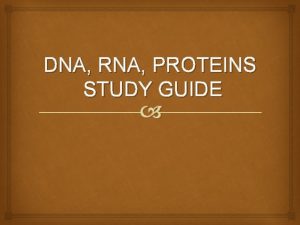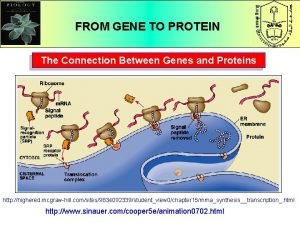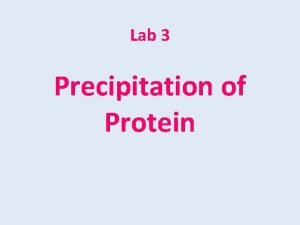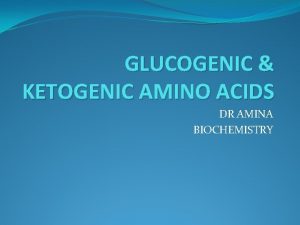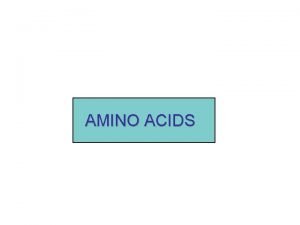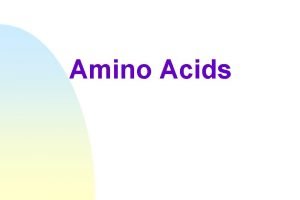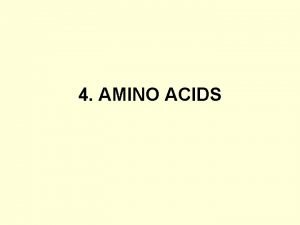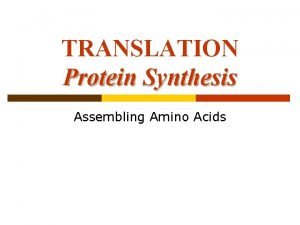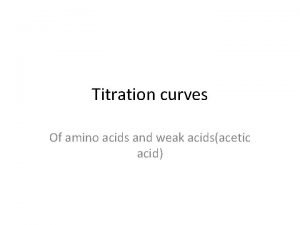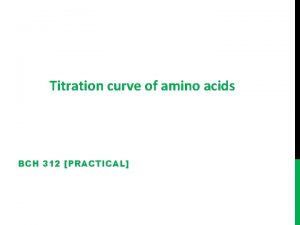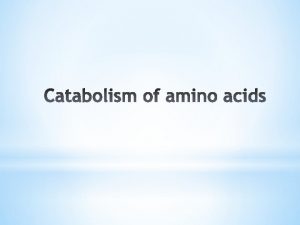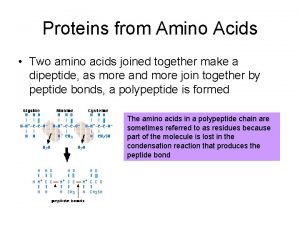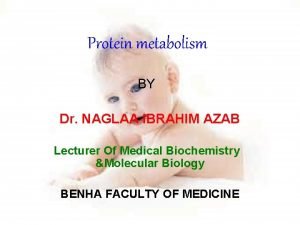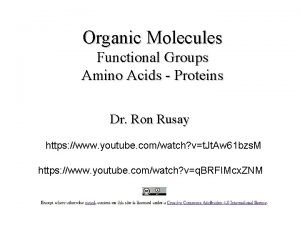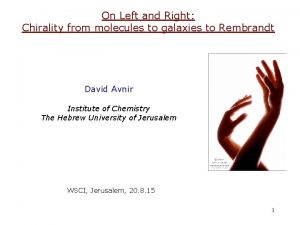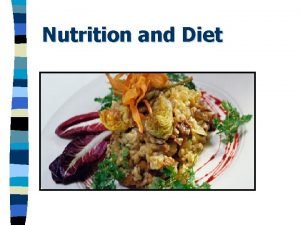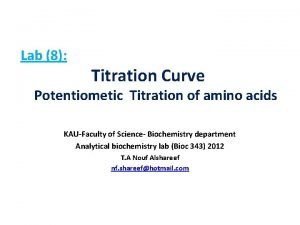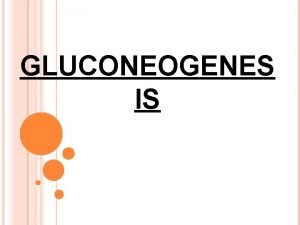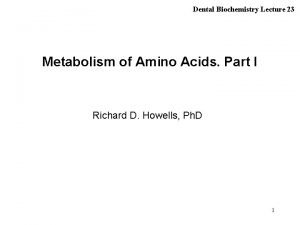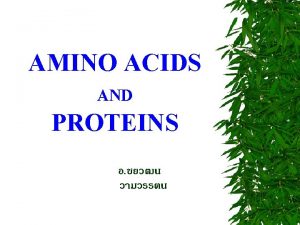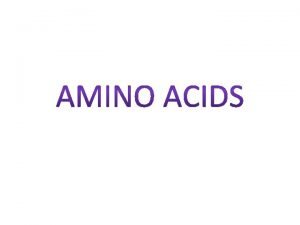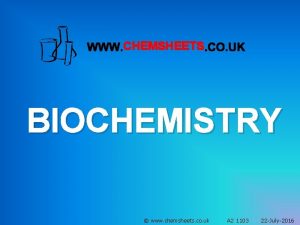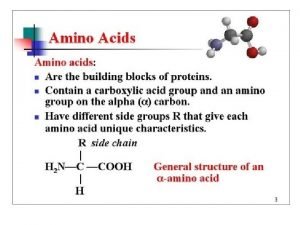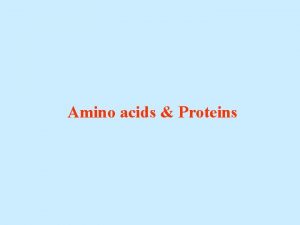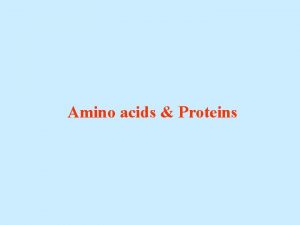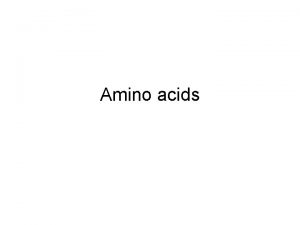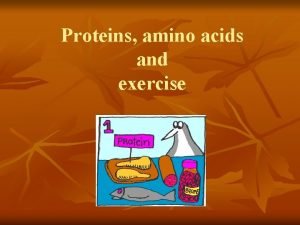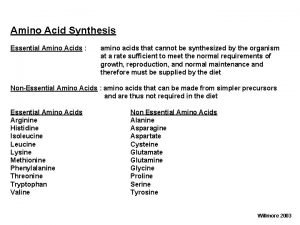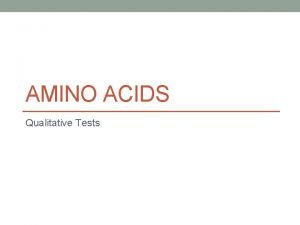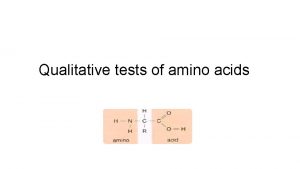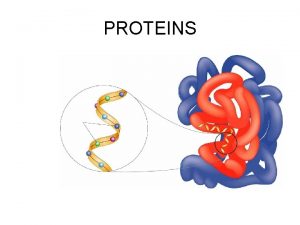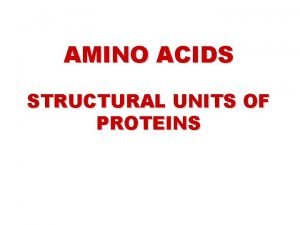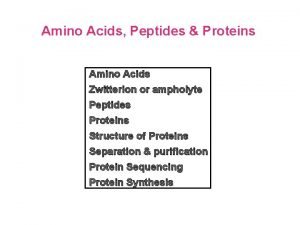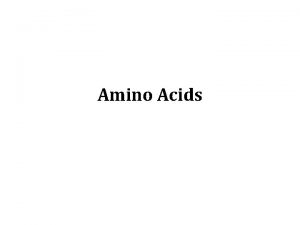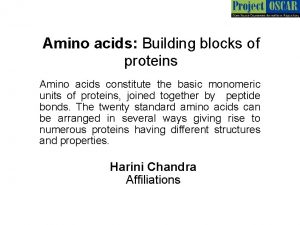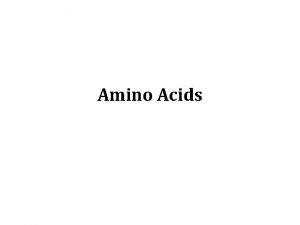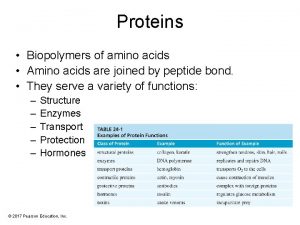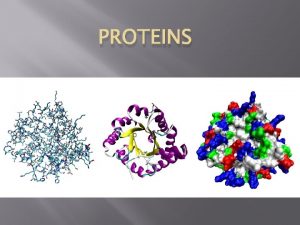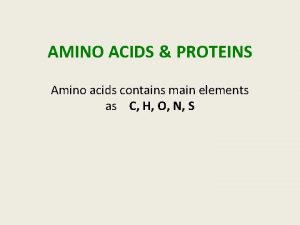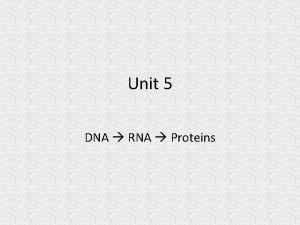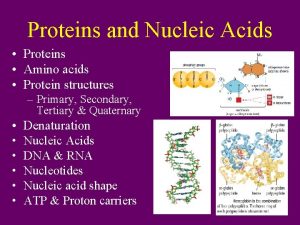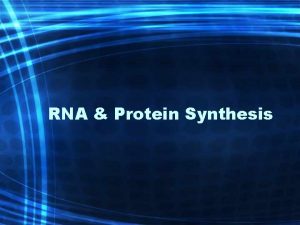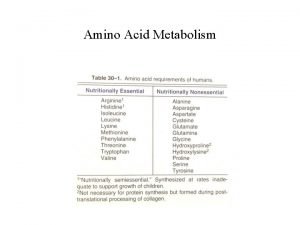DNA RNA Amino Acids Proteins and Genes DNA


























- Slides: 26

DNA, RNA, Amino Acids, Proteins, and Genes!

DNA • DNA is a nucleic acid, made of long chains of nucleotides Phosphate group Nitrogenous base Sugar Phosphate group Nitrogenous base (A, G, C, or T) Nucleotide Thymine (T) Sugar (deoxyribose) DNA nucleotide Polynucleotide Sugar-phosphate backbone Copyright © 2003 Pearson Education, Inc. publishing as Benjamin Cummings Figure 10. 2 A

• DNA has four kinds of bases, A, T, C, and G Thymine (T) Cytosine (C) Adenine (A) Guanine (G) Figure 10. 2 B Copyright © 2003 Pearson Education, Inc. publishing as Benjamin Cummings

• RNA is also a nucleic acid – different sugar – Uracil instead of Thymine – Single strand Nitrogenous base (A, G, C, or U) Phosphate group Uracil (U) Sugar (ribose) Copyright © 2003 Pearson Education, Inc. publishing as Benjamin Cummings Figure 10. 2 C, D

DNA is a double-stranded helix • James Watson and Francis Crick worked out the three-dimensional structure of DNA, based on work by Rosalind Franklin Figure 10. 3 A, B Copyright © 2003 Pearson Education, Inc. publishing as Benjamin Cummings

• Hydrogen bonds between bases hold the strands together: A and T, C and G Hydrogen bond Ribbon model Partial chemical structure Computer model Figure 10. 3 D Copyright © 2003 Pearson Education, Inc. publishing as Benjamin Cummings

Untwisting and replication of DNA • each strand is a template for a new strand Figure 10. 4 B Copyright © 2003 Pearson Education, Inc. publishing as Benjamin Cummings

• The information constituting an organism’s genotype is carried in its sequence of bases – The DNA is transcribed into RNA, which is translated into a protein DNA TRANSCRIPTION RNA TRANSLATION Protein Figure 10. 6 A Copyright © 2003 Pearson Education, Inc. publishing as Benjamin Cummings

RNA transcripts of DNA Copyright © 2003 Pearson Education, Inc. publishing as Benjamin Cummings

Translation of nucleic acids into amino acids • The “words” of the DNA “language” are three bases in a row called codons – The codons in a gene specify the amino acid sequence of a protein Copyright © 2003 Pearson Education, Inc. publishing as Benjamin Cummings

Gene 1 Gene 3 DNA molecule Gene 2 DNA strand TRANSCRIPTION RNA Codon TRANSLATION Polypeptide Figure 10. 7 Amino acid Copyright © 2003 Pearson Education, Inc. publishing as Benjamin Cummings

Virtually all organisms share the same genetic code “unity of life” Second Base C U UUC UUA UUG C CUU CUC CUA CUG A AUU AUC ile AUA AUG met (start) ACU ACC ACA ACG G GUU GUC GUA GUG GCU GCC GCA GCG phe leu val UCU UCC UCA UCG CCU CCC CCA CCG A ser UAU UAC UAA UAG pro CAU CAC CAA CAG thr AAU AAC AAA AAG ala GAU GAC GAA GAG G tyr stop his gln asn lys asp glu UGU UGC UGA UGG CGU CGC CGA CGG AGU AGC AGA AGG GGU GGC GGA GGG cys stop trp arg ser arg gly U C A G Third Base First Base U

• An exercise in translating the genetic code Transcribed strand DNA Transcription RNA Start codon Polypeptide Copyright © 2003 Pearson Education, Inc. publishing as Benjamin Cummings Translation Stop codon Figure 10. 8 B

Transfer RNA molecules serve as interpreters during translation • In the cytoplasm, a ribosome attaches to the m. RNA and translates its message into a polypeptide • The process is aided by transfer RNAs Amino acid attachment site Hydrogen bond RNA polynucleotide chain Anticodon Figure 10. 11 A Copyright © 2003 Pearson Education, Inc. publishing as Benjamin Cummings

Ribosomes build proteins Next amino acid to be added to polypeptide Growing polypeptide t. RNA molecules P site A site Growing polypeptide Large subunit t. RNA P m. RNA binding site A m. RNA Codons m. RNA Small subunit Figure 10. 12 A-C Copyright © 2003 Pearson Education, Inc. publishing as Benjamin Cummings

• m. RNA, a specific t. RNA, and the ribosome subunits assemble during initiation Large ribosomal subunit Initiator t. RNA P site A site Start codon m. RNA Small ribosomal subunit 1 Figure 10. 13 B Copyright © 2003 Pearson Education, Inc. publishing as Benjamin Cummings 2

Elongation • The m. RNA moves a codon at a time relative to the ribosome – A t. RNA pairs with each codon, adding an amino acid to the growing polypeptide – A STOP codon causes the m. RNA-ribosome complex to fall apart Copyright © 2003 Pearson Education, Inc. publishing as Benjamin Cummings

Amino acid Polypeptide A site P site Anticodon m. RNA 1 Codon recognition m. RNA movement Stop codon New peptide bond 3 Translocation Copyright © 2003 Pearson Education, Inc. publishing as Benjamin Cummings 2 Peptide bond formation Figure 10. 14

Table 14. 2 Types of RNA Type of RNA Functions in Messenger RNA (m. RNA) Nucleus, migrates to ribosomes in cytoplasm Transfer RNA (t. RNA) Cytoplasm Provides linkage between m. RNA and amino acids; transfers amino acids to ribosomes Ribosomal RNA (r. RNA) Cytoplasm Structural component of ribosomes Function Carries DNA sequence information to ribosomes

Review: The flow of genetic information in the cell is DNA RNA protein • The sequence of codons in DNA spells out the primary structure of a polypeptide – Polypeptides form proteins that cells and organisms use Copyright © 2003 Pearson Education, Inc. publishing as Benjamin Cummings

Mutations can change the meaning of genes • Mutations are changes in the DNA base sequence – caused by errors in DNA replication or by mutagens – change of a single DNA nucleotide causes sicklecell disease Copyright © 2003 Pearson Education, Inc. publishing as Benjamin Cummings

Normal hemoglobin DNA m. RNA Mutant hemoglobin DNA m. RNA Normal hemoglobin Glu Figure 10. 16 A Copyright © 2003 Pearson Education, Inc. publishing as Benjamin Cummings Sickle-cell hemoglobin Val

• Types of mutations NORMAL GENE m. RNA Protein Met Lys Phe Gly Ala Lys Phe Ser Ala BASE SUBSTITUTION Met Missing BASE DELETION Met Lys Copyright © 2003 Pearson Education, Inc. publishing as Benjamin Cummings Leu Ala His Figure 10. 16 B

• Chromosomal changes can be large or small Deletion Homologous chromosomes Duplication Inversion Reciprocal translocation Nonhomologous chromosomes Copyright © 2003 Pearson Education, Inc. publishing as Benjamin Cummings Figure 8. 23 A, B

• Summary of transcription and translation TRANSCRIPTION DNA m. RNA polymerase Stage 1 m. RNA is transcribed from a DNA template. Amino acid TRANSLATION Enzyme Stage 2 Each amino acid attaches to its proper t. RNA with the help of a specific enzyme and ATP. t. RNA Initiator t. RNA m. RNA Figure 10. 15 Copyright © 2003 Pearson Education, Inc. publishing as Benjamin Cummings Anticodon Large ribosomal subunit Start Codon Small ribosomal subunit Stage 3 Initiation of polypeptide synthesis The m. RNA, the first t. RNA, and the ribosomal subunits come together.

New peptide bond forming Growing polypeptide Codons Stage 4 Elongation A succession of t. RNAs add their amino acids to the polypeptide chain as the m. RNA is moved through the ribosome, one codon at a time. m. RNA Polypeptide Stop Codon Figure 10. 15 (continued) Copyright © 2003 Pearson Education, Inc. publishing as Benjamin Cummings Stage 5 Termination The ribosome recognizes a stop codon. The polypeptide is terminated and released.
 Amino acids are joined together in proteins by
Amino acids are joined together in proteins by Dna rna and proteins study guide answers
Dna rna and proteins study guide answers What is the connection between genes and proteins
What is the connection between genes and proteins Linked genes and unlinked genes
Linked genes and unlinked genes Linked genes and unlinked genes
Linked genes and unlinked genes Chapter 11 dna and genes
Chapter 11 dna and genes What are homeotic genes
What are homeotic genes Precipitation of proteins by strong mineral acids
Precipitation of proteins by strong mineral acids Purely ketogenic amino acids
Purely ketogenic amino acids Polar and non polar amino acids
Polar and non polar amino acids Glucogenic amino acid
Glucogenic amino acid Difference between hydrophobic and hydrophilic amino acids
Difference between hydrophobic and hydrophilic amino acids Dehydration synthesis of amino acids
Dehydration synthesis of amino acids Aspartate titration curve
Aspartate titration curve Titration curve of amino acids
Titration curve of amino acids Deamination of amino acids
Deamination of amino acids When two amino acids are joined together
When two amino acids are joined together Transdeamination definition
Transdeamination definition 20 amino acid structure
20 amino acid structure Chirality definition
Chirality definition N
N Pi of alanine
Pi of alanine Gluconeogenic amino acids
Gluconeogenic amino acids Glutamate oxidative deamination
Glutamate oxidative deamination Phenylalanine titration
Phenylalanine titration Amino acids classification
Amino acids classification Chemsheets a2 1102 amino acids 2 answers
Chemsheets a2 1102 amino acids 2 answers

